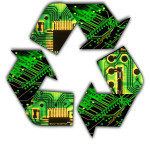Recycling: The Process
Schedule and Pick Up: This is the first step in our process where a pick up date and time is scheduled and picked up with one of our 26′ box trucks or our 53′ trailer. Secure Recycling will load your material and transport your assets to our facility dock.
Receiving: All of your assets are received, weighted and logged into our system. It is at this point that we label every pallet and establish a unique identifier that we use to track your assets throughout our entire process.
Product Sort: Every piece is weighed individually and logged into our system. This is where any and all asset tags are removed. We sort units by product type. All CRT monitors are routed to the CRT monitor processing area, all laptops, tablets, PDA Devices are processed through the Laptop Testing and Refurbishment Department, all computers and servers get processed through the Computer Testing and Refurbishment Department, all LCD Monitors, LCD Televisions get processed through our LCD Testing and Refurbishment Department, all printers and peripherals get processed, tested and prepared for resale and/or de-manufacturing. Segmenting these units by type creates efficiencies in our process which allow us to lower our total cost to you.
Tech Sort Line: There is a minimum requirement we have established for each product type and is based on the level of value recovery potential. For example, a 15-inch CRT monitor that is over 3 years old will fail and go directly to the End-Of-Life process. This is also true of a PC with a processor speed under 2.8 GHZ. But faster processors and newer/larger monitors would pass and go to the next step. This line changes as technology changes and is driven by the marketplace for pre-owned IT assets.
Configuration / Data Wipe: This is where we document the specific configuration of the asset (ex. Dell Optiplex PC, Pentium 4 processor, 1G RAM, CD/DVD) and data-wipe the hard drive using our DOD 5220.22-M compliant process. This process uses a certified drive-erasure program that is initiated by communicating with the hard drive through the BIOS. The drive is overwritten twice using ones and zeros, followed by a third pass using random characters.
Following Configuration / Data Wipe, there is another pass/fail decision point. This is for units that may have a significant amount of missing or non functional parts (ex. RAM, CD) or are in very poor cosmetic condition.
Units that pass go directly to the Testing area. This is where the unit and all of its components are comprehensively tested to ensure they are suitable for re-marketing, charitable donation, employee purchase, or internal redeployment. Units that need some level of repair may pass the Testing area. This is generally minor cosmetic repair or parts replacement. Units that are not cost-effective to repair go to the End-Of-Life process where there is a full dismantle and break down to its commodity.
All of this activity culminates in the Quality Check process. This is where a quality technician verifies that the unit is ready for sale or deployment.





